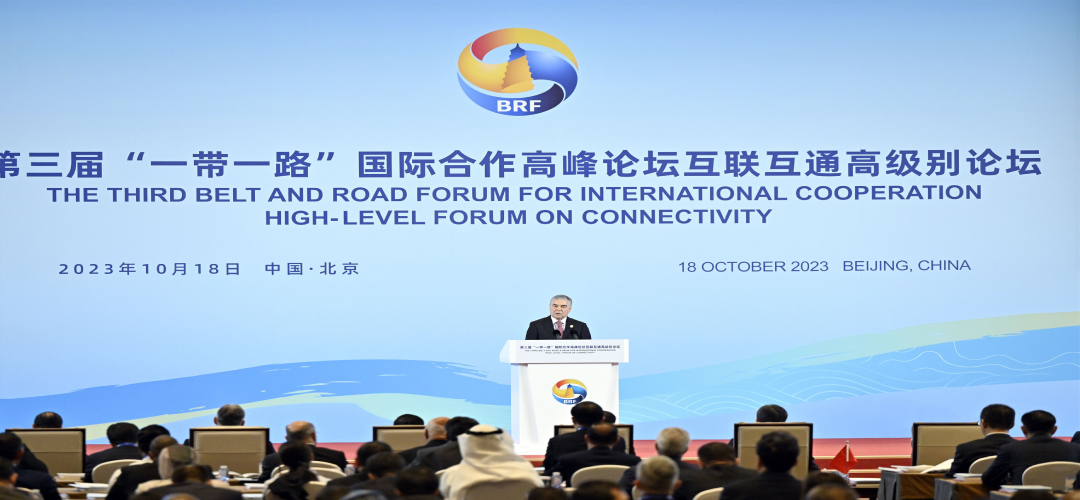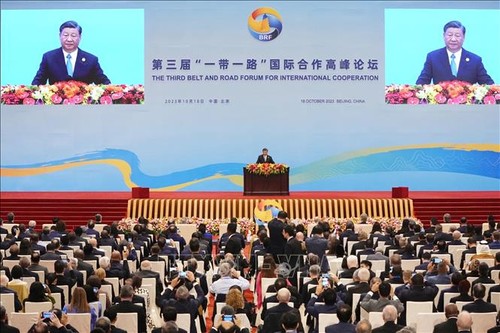The Global Benefactor?
November 4, 2023 | Expert Insights

The 3rd Belt and Road Forum for International Cooperation (BRF), held in Beijing from October 18-20, 2023, was a milestone in the ongoing development of the Belt and Road Initiative (BRI). This ambitious initiative, launched by China in 2013, aims to create a vast network of infrastructure and development projects connecting more than 130 countries and regions across Asia, Africa, Europe, and Latin America. Beijing claims that BRI has generated nearly half a million jobs globally and raised out of poverty nearly 40 million people, mostly in underdeveloped regions.
China, under President Xi Jinping, has made no secret of its ambition to make Eurasia (led by Beijing) the principal economic and trading hub in competition with the existing transatlantic alliances. Beyond its geopolitical outreach, China wants to put to profitable use the vast excess capacity in construction material that the country produces domestically to create infrastructure that will link the manufacturing centres in the Chinese heartland with its markets across the globe but mainly in Eurasia and Africa.
Background
The theme of the 3rd BRF was "High-quality Belt and Road Cooperation: Together for Common Development and Prosperity." It brought together leaders and representatives from over 130 countries and international organizations to deliberate on the future of the BRI and how to ensure its continued positive impact on the world. In his opening speech at the forum, Chinese President Xi Jinping pledged to continue to support the BRI and to work with other countries to build a more prosperous and sustainable future for all.
"The Belt and Road Initiative is a vision for common development and prosperity," Xi said. "It is a platform for cooperation and a bridge to the future." Xi also announced several new initiatives to support the BRI, including a $1 trillion investment fund and a new Global Artificial Intelligence Governance Initiative. In his opening speech at the forum, Chinese President Xi Jinping announced a number of new initiatives that reflect the lessons that China has learned from its first decade of BRI investments.
One of the most important lessons that China has learned is the need for greater transparency and consultation. BRI has been criticized for its lack of transparency and its top-down approach. In response to these criticisms, China has pledged to be more transparent and to consult more closely with partner countries on BRI projects.
Another important lesson China has learned is the need to ensure the sustainability of BRI projects. Some BRI projects have been accused of being white elephants or causing environmental damage. In response to these criticisms, China has pledged to focus on sustainable development and to promote green BRI projects.
Finally, China has also learned the need to align BRI projects with the local priorities of partner countries. China has been accused of imposing its own priorities on partner countries. In response to these criticisms, China has pledged to be more responsive to the needs of partner countries.
China's newfound emphasis on sustainable development and local alignment is a positive development. It demonstrates a commitment to transforming the BRI into a more constructive force for global development.
The BRF was met with mixed reactions from the international community. Some countries praised the initiative for its potential to boost global trade and investment. Others expressed concerns about the BRI's debt risks and its potential to be used by China to advance its geopolitical interests. Despite the mixed reactions, the BRF is a sign of China's growing influence on the global stage. The initiative is also a reflection of the rising voice of the new world as developing countries become more important players in the global economy.

Analysis
One of the key takeaways from this forum is the evolution of the BRI. China's focus has shifted from merely building infrastructure to embracing broader principles of sustainable development, green energy, and digital connectivity. The BRI is no longer solely about constructing physical connections but also about creating a sustainable and interconnected world.
Another significant takeaway is the growing global interest in the BRI. More and more countries are looking to engage with and participate in the initiative. China is actively working to foster a global community of partners that can contribute to and support the BRI's objectives.
The 3rd BRF also highlighted the emergence of a "new world" in which developing countries play a more prominent role in shaping the BRI. These countries are advocating for a more equitable and sustainable approach to development. They are setting their priorities within the framework of the BRI and demanding that projects be tailored to meet their specific needs. Additionally, developing countries are seeking a greater voice in the decision-making process and calling for increased transparency and accountability.
However, the BRI still faces challenges that must be addressed. One of these challenges involves ensuring that BRI projects are financially sustainable. Many developing countries have concerns about taking on excessive debt in the name of the BRI, and it is crucial to strike a balance between funding development projects and preventing debt crises. We have the examples of Sri Lanka and Pakistan in our neighbourhood.
View from India
BRI) carries significant implications for India, encompassing both favourable and unfavourable aspects.
On the negative side, the BRI is perceived as a means for China to expand its influence within India's neighbouring countries, particularly Pakistan, Bangladesh, Nepal and Sri Lanka. This has raised concerns about a potential strategic encirclement of India.
Furthermore, the considerable Chinese investment in Pakistan, notably through the China-Pakistan Economic Corridor (CPEC), which links western China to the Arabian Sea, is a source of apprehension. India worries that CPEC could provide China access to the Indian Ocean, potentially for military purposes. Now, even Afghanistan seeks an invitation to join it as a participant of the CPEC. Additionally, the BRI could introduce increased competition from China in export markets, potentially impacting the Indian economy.
Conversely, there are positive implications for India. The BRI offers an opportunity for India to attract investment and foster trade with China and other developing nations, which could contribute to economic growth. It also provides a platform for India to advance its own development priorities, with a focus on infrastructure development and enhanced connectivity. Collaborative efforts with China on infrastructure projects have the potential to better link India with its neighbours and the global community.
To optimize the benefits of the BRI, India must meticulously evaluate both the advantages and risks. Project selection should align with India's specific development goals and be of mutual benefit to all stakeholders. Negotiating favourable terms for projects, ensuring transparency, and preventing excessive debt are crucial steps for India's participation. Additionally, safeguarding its strategic interests through the development of independent infrastructure and collaboration with other nations to create a regional counterbalance to China's influence is essential.
Assessment
- The rising voice of the new world, represented by developing countries, is a crucial factor in the future of the BRI. These nations are demanding a more equitable and sustainable approach to development, and their involvement and influence will be instrumental in shaping the future of the initiative. China must listen to their concerns and work collaboratively to build a more inclusive and participatory BRI.
- The potential for the BRI to be a positive force in the world hinges on China and its partners' ability to address the challenges ahead. If they can ensure financial sustainability, environmental responsibility, and social benefits, the BRI has the potential to be a global success. However, neglecting these challenges could transform the BRI into a source of conflict and tension on the international stage.
- India has valid reasons for concerns related to the BRI; the initiative can be seen as a means for China to extend its influence in India's vicinity. Furthermore, increased Chinese investment in Pakistan, viewed as a security threat by India, is a cause for apprehension. There is also the potential for heightened competition with China in the export market, especially if the planned India-Middle East Europe corridor project takes shape, an eventuality badly hamstrung by the Gaza war.








Comments